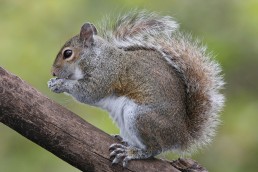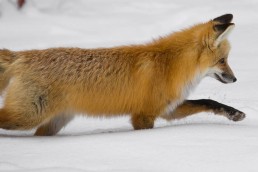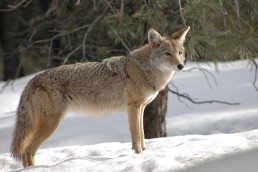Late-winter Squirrel Hunting: Focus on the Food Sources
SHARE THIS POST
I was slipping along the edge of the creek bottom, looking ahead, trying to spot the telltale movement of a feeding squirrel. A flicker of movement caught my eye, and I made out a rusty red shape sitting low in a tree, nibbling on a cob of field corn. I was able to close the gap to about 35 yards when the big fox squirrel caught my movement, and made for the tall oaks that lined the creek bottom. A one-ounce load of #4 shot from my 20-gauge stopped him cold. My long, cold walk in the light snow had paid off! A little further down where there were a few more oaks, I was able to harvest a nice young gray squirrel. My winter hunt had provided some of the makings for squirrel stew.
Wisconsin is home to several species of squirrels, the gray (Sciurus carolinensis) the fox (Sciurus niger) and the red or piney squirrel (Tamisciurus hundsonius). Probably the most popular and widely distributed is the common gray. Fox squirrels are generally larger than grays, less common and tend to show up around agricultural areas with cornfields. The smallest of the group, the red or pine squirrel tends to hang around large stands of evergreens, but will venture into mixed hardwoods. Due to the pine squirrel’s small size and diet of pine nuts, it’s seldom hunted. The current bag limit is five squirrels, and I can only ever remember limiting out once. Wisconsin’s squirrel hunting season ends on January 31.
Late winter squirrels tend to conserve their energy, and prefer to feed on calm, windless winter mornings. I suggest scouting to find the feeding areas they are using. Oak, walnut or hickory trees, apple or other fruit trees, or harvested corn and soybean fields will all attract squirrels. Look for tracks and for signs of where they have been foraging for food. They have also been known to come into farmyards and raid corncribs or cattle feed. Unlike earlier in the year when they will feed all morning, in winter they seem to hit the food source and run.
Spot and stalk versus sit and wait
I was taught to hunt squirrels by my grandfather. He would get into the woods before first light, and stake out an area with large oaks. Then he would sit in cover and wait. After first light, you would listen for squirrels scampering around in the leaves looking for acorns. Grandpa would let several squirrels come into view, and then open up on them with his Browning A5 shotgun. We would leave the squirrels there until we were ready to go, as usually within an hour, other squirrels would show up to feed. This was pretty much how I squirrel hunted, stand hunting a food source. It’s a great way to introduce youngsters to hunting (as I was) and gives you the nice, close, high-percentage shots at calm, feeding squirrels.
Are you enjoying this post?
You can be among the first to get the latest info on where to go, what to use and how to use it!
Spot-and-stalk squirrel hunting allows you to cover more areas, and often catch squirrels that feed in from different areas. The family I deer hunt with in Iowa harvests dozens of squirrels every year, and the majority are shot spot-and-stalk or still-hunting through the vast Shimek State Forest in southeastern Iowa. Moving slowly, usually in a two-man team, they look for squirrels moving or feeding ahead of them. Most times, one carries a .22 for stationary targets and the other a shotgun for running squirrels. Having two hunters pays off when a squirrel is in the top of a tall oak, and keeps circling the tree to avoid giving the hunter a clear shot. I once shot a nice gray that had jumped to another tree to avoid my friend Sonny. Sonny had never even seen the crafty squirrel leave the tree. He later dropped a gray that pulled the same trick on me. Had we not been hunting together, both squirrels would have escaped.
Guns and loads
Most any shotgun will cleanly kill a squirrel, depending on the range at which you engage the squirrels. I harvested lots of squirrels with a .410 shotgun and 3-inch loads of #6 shot growing up. Most were shot inside 30 yards, while sitting and waiting for them. A squirrel going full speed, jumping from limb-to-limb at 40 yards requires a full choke and heavier loads of larger shot. Try 1-ounce loads of #4 or #6 lead shot for a 20 gauge, or 1-ounce to 1 1/4-ounce loads of #4 or #6 shot in your 12 gauge. If you shoot steel shot exclusively, try steel #4 or #3 shot in either 12 or 20 gauge.
Rimfire rifles (where legal) are the classic squirrel-harvesting tools. Rifles work best when the squirrel is stationary, so you may want to wait for that perfect shot. I have both a semi-auto .22 long rifle, and a bolt action scoped .22 magnum I have used for squirrels. I prefer the scoped .22 magnum, as it’s accurate enough to take a squirrel out of the top of a tall oak. The added power of the .22 magnum round also helps on marginal hits. The use of hollow point bullets helps to prevent the chance of a bullet bouncing off a frozen tree trunk, as well as helping anchor the squirrel. Safety First—make sure the background is safe before taking a shot with a rifle, since a .22 bullet can travel nearly a mile.
MWO
SHARE THIS POST
Did you enjoy this post?
You can be among the first to get the latest info on where to go, what to use and how to use it!
Ron Stresing
Ron Stresing has fished since age 4 and hunted since age 12, with a lifelong passion for both. He tries to convey the lessons learned over a lifetime of hunting and fishing in Wisconsin. He also writes a column on shotguns for On Wisconsin Outdoors.



Great squirrel hunting tips. My favorite way to hunt squirrels is along creeks any time of year.